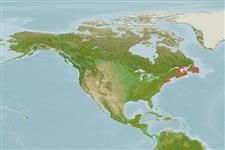Environment: milieu / climate zone / depth range / distribution range
Ecologie
marien; zoet water; brak water benthopelagisch; diepte 0 - 3 m (Ref. 85409). Temperate; 4°C - 20°C (Ref. 2059); 51°N - 35°N
Western Atlantic: Gulf of St. Lawrence in Canada to North Carolina, USA. Mainly a near-shore marine species, but far inland populations occur in lakes in Nova Scotia in Canada and in Hudson, Delaware and Susquehanna River drainages (Ref. 5723).
Grootte / Gewicht / Leeftijd
Maturity: Lm ? range ? - ? cm
Max length : 6.4 cm TL mannelijk / geslacht onbekend; (Ref. 5723); common length : 4.1 cm TL mannelijk / geslacht onbekend; (Ref. 12193); max. gerapporteerde leeftijd: 3.00 Jaren (Ref. 12193)
Adults occur mainly along weedy bays and backwaters, entering brackish water and to a limited extent, fresh water (Ref. 3814). Feed along the bottom, primarily on diatoms, worms and crustaceans by sucking in the prey with a pipetting action (Ref. 27549). Males build, guard and aerate the nest where the eggs are deposited (Ref. 205).
Levenscyclus en paargedrag
Maturiteit | Voortplanting | Paaien | Eieren | Fecunditeit | Larven
The male builds, guards and aerates the nest (Ref. 205).
Robins, C.R., R.M. Bailey, C.E. Bond, J.R. Brooker, E.A. Lachner, R.N. Lea and W.B. Scott, 1991. Common and scientific names of fishes from the United States and Canada. Am. Fish. Soc. Spec. Publ. (20):183 p. (Ref. 3814)
Status op de Rode Lijst van het IUCN (Ref. 130435)
Gevaar voor de mens
Harmless
Gebruik door de mens
Aquarium: Publieke aquaria
Meer informatie
ReferentiesAquacultuurAquacultuurprofielKweeklijnenGeneticaElectrophoresesErfelijkheidZiektesVerwerkingNutrientsMassaconversie
Tools
Speciale rapporten
Download XML
Internetbronnen
Estimates based on models
Preferred temperature (Ref.
123201): 4.2 - 12.7, mean 6.4 °C (based on 228 cells).
Fylogenetische diversiteitsindex (Ref.
82804): PD
50 = 1.0000 [Uniqueness, from 0.5 = low to 2.0 = high].
Bayesian length-weight: a=0.01047 (0.00408 - 0.02689), b=3.07 (2.85 - 3.29), in cm total length, based on LWR estimates for this (Sub)family-body shape (Ref.
93245).
Trofisch niveau (Ref.
69278): 3.2 ±0.38 se; based on food items.
Generation time: 1.3 ( na - na) years. Estimated as median ln(3)/K based on 2
growth studies.
Weerstandsvermogen (Ref.
120179): Hoog, minimale populatieverdubbelingstijd minder dan 15 maanden (K=0.84; tmax=3).
Fishing Vulnerability (Ref.
59153): Low vulnerability (16 of 100).
